

United States Visas: How to Work as a Mexican Programmer in Silicon Valley
“…More and more Mexican programmers are looking for a job opportunity in Silicon Valley , and in the United States in general. And the fact is that the most famous technological hub in the world offers ample possibilities to develop and grow professionally, in addition to salaries that range from 80 thousand dollars to more than one million dollars a year , depending on the professional’s experience…”
https://www.entrepreneur.com/article/365914
Skilled Workers and Professionals Keep Visa Rights under New USMCA Trade Deal
“After months of negotiations following US President Donald Trump’s pledge to scrap NAFTA, the 24 year old trade agreement between Canada, the USA and Mexico, a new deal was reached minutes before a midnight deadline on September 30, 2018. Despite a number of changes, the new agreement – rechristened the United States-Mexico-Canada Agreement (USMCA) – leaves NAFTA provisions for work visas untouched. The retention of the visa program is significant for workers in over 60 professional categories, and for employers across the continent, who will continue to have access to labor from all three countries..”
How technology will change us after the COVID-19 pandemic is over
“…When Rice University suspended classes in early March after a staff member tested positive for the coronavirus, three for-credit courses were available online. When Rice’s classes restarted on March 23, 1,906 online courses were offered, said Klara Jelinkova, the university’s chief information officer.Setting all this up – including training 487 professors, many of whom had never taught online before – was “simultaneously exhilirating and scary,” Jelinkova said.Online education has been around for a while, and some universities are built entirely on it. But many colleges — and particularly K-12 schools — have not embraced it…”
The American middle class is stable in size, but losing ground financially to upper-income families
“..Financially, middle-class households in the U.S. were better off in 2016 than in 2010. The median income of middle-class households increased from $74,015 in 2010 to $78,442 in 2016, by 6%. Upper-income households (where 19% of American adults live) fared better than the middle class, as their median income increased from $172,152 to $187,872, a gain of 9% over this period. Lower-income households (29% of …”
Link to article
Mexican Startup Raised US$6M to Democratize Social-TV Advertisement
SANTA MONICA, Calif., April 9, 2018 /PRNewswire/ — Initially raising US$5 million to build a social network, Flyr shifted course a year ago to continue with the longtime dream from visionary VFX genius Hassan Uriostegui that one day the iPhone would be the new platform where everybody would access the power of creative software…
Link to article
Among U.S. Latinos, the internet now rivals television as a source for news
On a typical weekday, three-quarters of U.S. Latinos get their news from internet sources, nearly equal to the share who do so from television, according to a 2016 survey of Latino adults by Pew Research Center…
Link to article
Facebook Researchers Shut Down Artificial Intelligence That Created It’s Own Language
Facebook has recently developed a new artificial intelligence (AI), and it has since created its own language using code words to communicate more efficiently. Researchers promptly shut the system down over concerns that they might lose control over the A.I.
This isn’t the first time AIs have diverged from their training in the English language to develop their own, more efficient language. While the resulting phrases from this condensed method of communication sound like gibberish to the human ear, they do in fact make semantic sense when interpreted by AI agents…
Link to article
How Silicon Valley appropriates Mexican-American ideas, plus degrees of assimilation.
Ripping off music and movies? We call it piratería, and we know a guy at the Paramount Swap Meet who has Guardians of the Galaxy 3 on VHS. AirBnB? We’ve been renting out the couch to visitors since the days of the Toltecs. Uber? The aforementioned raiteros, what the gabacho media used to call gypsy cabs. Some app that you can use if you need someone to cut your lawn or fix your clogged toilet? Day laborers. Dia de los Muertos everything? BRUH…and all of this caca will continue…
Link to article
RANKING: Top 10 Video Platforms Preferred by US Hispanics
Which video platforms do US Hispanic users prefer? What types of content do they provide? Does gender play a role in audiovisual content preference? Read on for the answers to these questions, drawn from comScore’s February 2016 ranking…
Link to article
A Latino Is Called To Help The Tech-Sun Rise In Arizona
He did it in Boulder, Colorado. He did it in Silicon Valley, California. Now he’s been tapped — called — to help accelerate the startup scene in Tucson, Arizona.
Remy Arteaga was the subject of several stories I wrote here about the Stanford Latino Entrepreneurship Initiative — an innovative branch of one the the nation’s most ambitious NGO’s devoted to supporting Latino business owners — after serving as director of the Deming Center for Entrepreneurship at the University of Colorado-Boulder. In February this year, he was named director of the McGuire Center for Entrepreneurship at the University of Arizona in Tucson. When I first learned about it — over the Winter holiday break — I saw there were at least three things about Remy’s new gig that are noteworthy…
Link to article
Managing Diversity in Organizations: A Global Perspective
M Triana – 2017 – books.google.com
This book equips students with a thorough understanding of the advantages and challenges
presented by workplace diversity, suggesting techniques to manage diversity effectively and
maximize its benefits. Readers will learn to work with diverse groups to create a productive..
Link to book preview
Latino ‘Genius’ Grew Language-Learning App Duolingo to 150M Users
Ask Luis Von Ahn why he decided to become an entrepreneur and he will tell you that the career actually chose him. When he was a professor at Carnegie Mellon in 2005, he developed a program that websites could use to distinguish humans from robots. CAPTCHA became so popular that school officials urged Von Ahn to turn the program into something more.
“At some point the university was kicking the project out because it had too many users and they just said, ‘You can’t be in the university, you have to do something about it,'” he says. “I had to turn it into a company.”…
Link to article
Mexican American Proarchive: Annual Report on Mexican American Professionals
News from the census American Community Survey is generally good for the 2015 year. Mexican American college enrollment was up from 18.7% to 18.9% in the 2014 and 2015 years. Graduate or professional degree attainment was also up from 2.9% to 3.0%. The number of bachelor’s degrees granted to Mexican American students rose from 7.6% in 2014 to 7.8% in 2015.


In spite of these gains, Mexican Americans still remain at the bottom of the ladder when it comes to earning a bachelor’s degree. Even after broadening the group to Latinos or Hispanics, this group still lags behind. According to the Pew Hispanic Center: “As of 2014, among Hispanics ages 25 to 29, just 15% of Hispanics have a bachelor’s degree or higher. By comparison, among the same age group, about 41% of whites have a bachelor’s degree or higher (as do 22% of blacks and 63% of Asians).” Pew reports that the main reasons for this low graduation rate is that Hispanics are less likely “to enroll in a four-year college, attend an academically selective college and enroll full-time.”
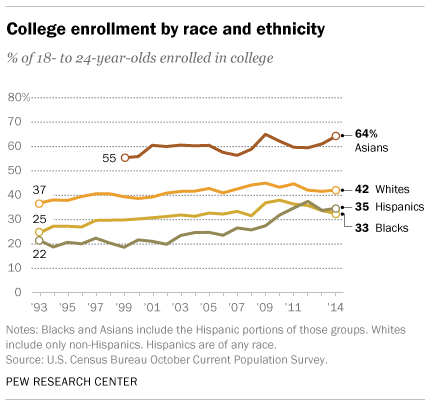
Also in the good news column, the University of California will continue to push for a greater number of underrepresented minorities; namely, Chicano/Latino students whose resident freshmen numbers rose from 2.7% to 32.3% of admitted California freshmen. In other good news, the proportion of Chicano/Latino students transferring from community colleges increased to 29.3% from 26.8% for 2015.
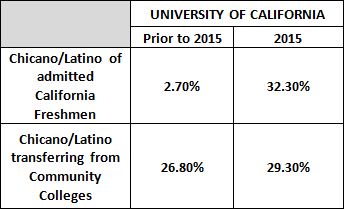
Occupations, including those in management, business, science, and art, fared better for Mexican Americans. The number of Mexican Americans filling these occupations rose from 17.4% in 2014 to 17.5% in 2015.

The total number of Hispanics filling these occupations was 16.1% in 2015, a bit lower than Mexican Americans specifically.
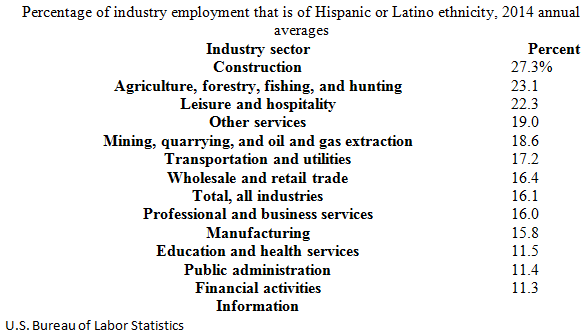
The report shows that industrial employment for Mexican Americans remained the same for 2014 and 2015 at 10.2%.
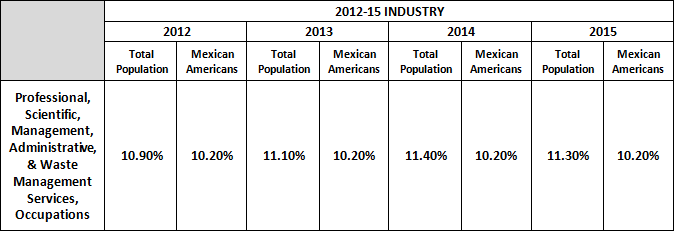
The figures for Hispanic or Latino employment for 2015 and 2016 show a healthy increase.
According to the Pew Hispanic center, “Construction, professional and business services, health services, financial services and food services…showed healthy gains.” Most of the jobs gained by native-born Hispanic workers were in manufacturing, mostly durable goods (82,000 Hispanic workers in this industry), followed by wholesale and retail trade (79,000), publishing, broadcasting, communication and information services (55,000), and construction (54,000).
Foreign-born Hispanics had the most job gains in construction (417,000), followed by business and professional services (179,000). Together, those two industries accounted for almost three-quarters (74%) of all jobs gained by foreign-born Latinos between 2005 and 2006.
The business and professional services sector, which ranges from management and technical services to janitorial, landscaping, and waste management services, is also a key employer for non-Hispanic workers. Of the total increase in employment in 2005-06, non-Hispanic workers accounted for 410,000 employees in the industry, native-born workers 327,000, and foreign-born workers 83,000.
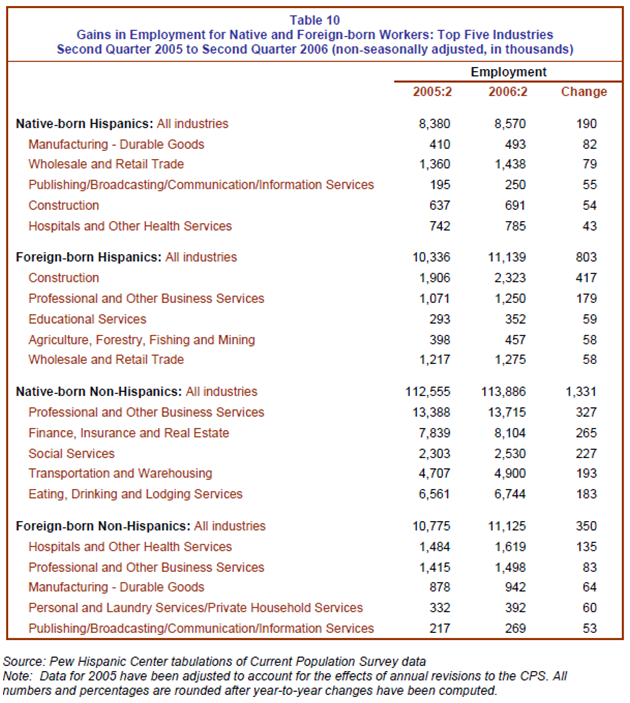
Sources
- Census Bureau, Selected Population Profile in the United States: 2015
- Pew Research Center
- University of California
- Bureau of Labor Statistics
Immigration Reform 2016 News – Facebook and Microsoft Say STEM, Immigrants Help U.S. Tech Companies Stay Competitive
Representatives from the country’s most affluent companies challenged the next presidential administration to revise education and immigration programs during a Democratic National Convention forum on Wednesday.
Members of the nonpartisan Information Technology and Innovation Foundation, which pushes for scientific and technological advancements, urged lawmakers to reform longstanding immigration laws that limit how long individuals can work or study in the United States. The panelists also said a lack of enthusiasm for STEM – science, technology, engineering, and mathematics – education programs among minorities makes it difficult to compete globally…
Link to article
A Latino Angel Wants To Help You Invest In Tech Startups
For the past two decades, I have been an advisor to many technology startups, and I can tell you this: raising the first million is the hardest.
Even harder: raising the first million if you are Latino/Latina founder.
Last week, DreamFunded – a San Francisco-based company that I’ve written about before — became the first SF-headquartered firm to get approval from FINRA to launch a portal that will enable many people — not just the rich — to invest in technology through crowdfunding. According to DreamFunded, it’s also the first Latino-led equity crowdfunding portal anywhere to get FINRA approval…
Link to article
5 Reasons Brands Should Use Facebook Instant Articles To Engage With U.S. Hispanics
Last month, Facebook announced that on April 12, they will be “opening up the Instant Articles program to all publishers—of any size, anywhere in the world.” Yes, this means that brands can now leverage Facebook Instant Articles to engage with consumers.
Facebook created Instant Articles to optimize the experience for users who click from Facebook to a third-party publisher’s website on their mobile devices. For brands, Instant Articles not only optimize page load times, but can be leveraged to create more immersive experiences that are integrated with the all-important Facebook news feed…
Link to article
Job Opportunities for Latinos — Marketing Specialist
Information is the key to success these days especially in business. Most companies, entrepreneurs and organization are even willing to spend millions just to gather important details they can use to know more and understand their customers. That’s why jobs that are inclined to its niche, like Market Specialists, have a projected demand increase of about 41 percent from 2010 to 2020…
Link to article
Technology startup seeks to connect Mexican IT workers with U.S. employers
Mexican Nationals seeking an opportunity in the United States typically face an extra barrier when it comes to visa sponsorship through employers. But one San Antonio startup hopes to ease that entry and help fill local bilingual information technology jobs.
Jesus ‘Tito’ Salas ran the San Antonio Mexican Entrepreneurial Challenge competition for Geekdom last year that sought to connect South Texas to Mexican startups…
Link to article
LinkedIn makes slight progress on diversity
SAN FRANCISCO — Change is coming very slowly to LinkedIn which over the past year only slightly increased the number of women and made no headway in increasing the number of underrepresented minorities at the professional networking company.
The Mountain View, Calif., company is still dominated by men, according to work force demographics released Tuesday. Nearly six out of 10 employees at LinkedIn — or 58% — are men, but that is an improvement from 61% last year.
Women also made some progress in the company leadership, holding 30% of those positions, a 5% increase from 2014.
In technical roles, women saw a 1% increase. In non-tech roles, LinkedIn had gender parity with 50% of those positions held by women.
But LinkedIn did not see any improvement in the small percentage of underrepresented minorities. In the U.S., 2% of LinkedIn employees are African American and 4% are Hispanic…
Link to article
Hispanic YouTubers Are First To Benefit From Google Advertising Initiative
Hispanic is the new Preferred on YouTube. Last year, Google introduced Google Preferred, a system of targeting specific top tier channels that would jibe with advertisers’ intents of reaching maximum audiences. This year, it’s all about being selective — and first up is the Hispanic audiences…
Link to article


